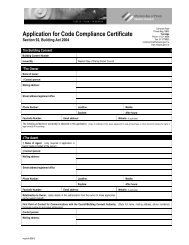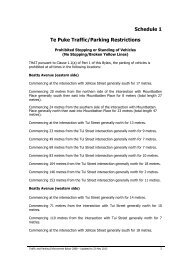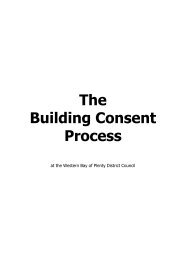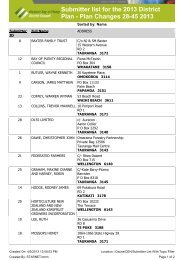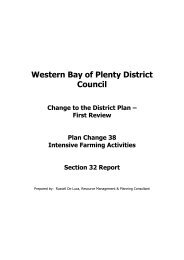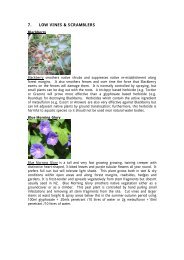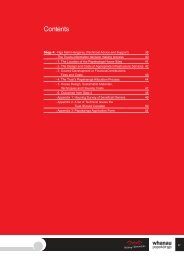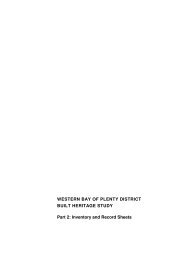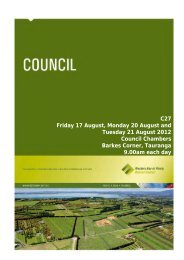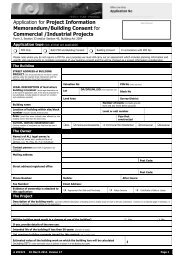2.16 - Western Bay of Plenty District Council
2.16 - Western Bay of Plenty District Council
2.16 - Western Bay of Plenty District Council
Create successful ePaper yourself
Turn your PDF publications into a flip-book with our unique Google optimized e-Paper software.
16. Traffic Islands andRoad Markings2 - 16
TRAFFIC ISLANDS AND ROAD MARKINGSExecutive SummarySection Two – Policy BackgroundTraffic islands and road markings are important mechanisms for controlling traffic.Pavement marking can increase traffic capacity, improve safety and contribute to the orderlyuse <strong>of</strong> the road. Raised traffic islands may be used to channelise streams <strong>of</strong> traffic andprovide refuge for pedestrians crossing roads. Pavement markings are also used tosupplement some types <strong>of</strong> traffic signs.<strong>Council</strong> requires a policy to provide guidance to Staff and Service Providers, to ensure thatall traffic islands and road markings in new and existing roads are enforceable and are incompliance with the Traffic Regulations 1976.<strong>Council</strong> sets standards for road markings and traffic islands in new developments throughthe Subdivision and Development Code <strong>of</strong> Practice. Installation <strong>of</strong> satisfactory trafficislands and road markings is the responsibility <strong>of</strong> the consent holder/developer.The provision and maintenance <strong>of</strong> traffic islands and road markings on existing roads is theresponsibility <strong>of</strong> Service Providers, under delegated authority from <strong>Council</strong>. The level <strong>of</strong>delegation is specified in contract documentation with the Service Provider.This report and attached policy document has identified the following:• Certain regulatory road markings require formal adoption through a <strong>Council</strong> bylaw orresolution before they are enforceable under the Traffic Regulations 1976. It isrecommended that these types <strong>of</strong> markings be included within a new Roads and TrafficBylaw for the <strong>District</strong>.• All <strong>Council</strong> bylaws (and any previous resolutions) relating to road markings thatregulate, prohibit or control traffic movements should be documented in a rapid recalldatabase for ease <strong>of</strong> reference and enforcement.• <strong>Council</strong>’s Code <strong>of</strong> Practice (Section 8.4(b)) references an outdated edition <strong>of</strong> the Manual<strong>of</strong> Traffic Signs and Markings (MOTSAM), and an outdated version <strong>of</strong> the Transit NZ-P/12 Specification for Pavement Markings. It is recommended that this be amended atthe time <strong>of</strong> the next Code <strong>of</strong> Practice review.16.1. PurposeThis report and attached policy document are written to provide guidance to subdividers,<strong>Council</strong> Staff and Service Providers, and aims to ensure that all traffic islands and roadmarkings in the <strong>Western</strong> BOP Roading Network are designed, installed and maintained incompliance with the Traffic Regulations 1976, and all other relevant legislation.This report also investigates enforcement issues with regard to those road markings thatregulate, control or prohibit vehicular movements.Roading Network Control Manual Section 2 - 16 Page 1 <strong>of</strong> 8FEBRUARY 2003
Section Two – Policy BackgroundPolicy RequirementsThe attached policy is required to ensure that all <strong>Council</strong> Staff, Service Providers andsubdividers are provided with clear guidance on design and enforcement requirements fortraffic islands and road markings.16.2 BackgroundAll traffic islands and road markings must comply with the Traffic Regulations 1976, and itsamendments. The provision <strong>of</strong> complying traffic islands and road markings for newdevelopments is the responsibility <strong>of</strong> the consent holder/developer (Section 8.4 Subdivisionand Development Code <strong>of</strong> Practice). The provision <strong>of</strong> complying traffic islands and roadmarkings on existing road is the responsibility <strong>of</strong> Service Providers, under delegatedauthority from <strong>Council</strong>.Specifications for new traffic islands and road markings are controlled through theSubdivision and Development Code <strong>of</strong> Practice. There is no <strong>Council</strong> policy givingspecifications for the maintenance <strong>of</strong> existing traffic islands and road markings.Certain types <strong>of</strong> road markings require formal adoption through a <strong>Council</strong> bylaw orresolution before they are enforceable under the Traffic Regulations 1976. These types <strong>of</strong>markings are listed in section 2.1.2 <strong>of</strong> this report. <strong>Council</strong> is given the mandate to draftbylaws regulating the use <strong>of</strong> roads in the <strong>District</strong> under Section 72 <strong>of</strong> the Transport Act1962.IssueCode <strong>of</strong> PracticeSection 8.4(b) <strong>of</strong> <strong>Council</strong>’s Subdivision and Development Code <strong>of</strong> Practice 2001 refers tospecific, dated versions <strong>of</strong> the MOTSAM Manual and the Transit NZ Specification forPavement Markings. These have both been superseded, as shown in the table below:Document: Replaced by: Significance:MOTSAM Edition 3,1995TNZ Specification forPavement Markings:April 1994MOTSAM Edition 4,1998TNZ Specification forPavement Markings:2001Between 1995 and 1998, the followingsections <strong>of</strong> the Traffic Regulations relatingto traffic islands and road markings wereamended:S. 106(5) to 106(7) on 1/1/1997S. 106A on 1/1/1997S. 109(1) on 20/1/1995The entire Specification Document wasreplaced.Roading Network Control Manual Section 2 - 16 Page 2 <strong>of</strong> 8FEBRUARY 2003
Section Two – Policy BackgroundIt is recommended that at the time <strong>of</strong> the next Code <strong>of</strong> Practice review, the Code be amendedto make reference to the most recent editions and “any subsequent edition” <strong>of</strong> the abovedocuments.Enforcement <strong>of</strong> Road MarkingsUnder the Traffic Regulations, <strong>Council</strong> is responsible for ensuring pavement markings arebacked by any necessary formal authorisation procedures.47 Formal authorisation (such asa bylaw or <strong>Council</strong> resolution) is required for the following types <strong>of</strong> road markings to beenforceable.The discipline <strong>of</strong> a Bylaw, however, brings about a higher level <strong>of</strong> quality in process.Special VehiclesThese markings are used where <strong>Council</strong> has restricted parking to a certain class <strong>of</strong> vehicle.These markings should only be used in conjunction with appropriate regulatory signs, asdescribed in the MOTSAM Manual:• Taxi Stands• Bus Stops• Loading Zones• Motorcycle Parks• Bicycle Stands• Disabled Parking Spaces• Cycle LanesStopping and Parking RestrictionsThese markings are used in areas where <strong>Council</strong> has formally restricted the stopping andstanding <strong>of</strong> all vehicle types:• No Stopping Lines (broken yellow lines)• Parking AreasOther• Pedestrian crossings and fire hydrants also requires special authorisation or roadmarkings:• Pedestrian Crossings in areas where the speed limit exceeds 50km/h require thewritten consent <strong>of</strong> the Director <strong>of</strong> the Land Transport Safety Authority.47 Regulations 35, 108 and 109 Traffic Regulations 1976.Roading Network Control Manual Section 2 - 16 Page 3 <strong>of</strong> 8FEBRUARY 2003
Section Two – Policy Background• Every Local Authority is required by law to indicate the position <strong>of</strong> fire hydrants byconspicuous marks or notices. 4816.3 LegislationTraffic Regulations, Local Government Act, Transport ActLegislation relating to traffic islands and road markings is contained in the TrafficRegulations 1976, Local Government Act 1974, Land Transport Act 1998 and the TransportAct 1962. Relevant legislation is included in Appendix <strong>2.16</strong>A.Subdivision and Development Code Of PracticeSection 8.4 (Road Marking) <strong>of</strong> the Code states:(a) Where road marking and signage are required as an integral part <strong>of</strong> the roadingfunction, it is the consent holders responsibility to provide these facilities. Such roadmarking and signage shall be detailed and installed in accordance with the <strong>Council</strong>s“Traffic Services Guidelines”. See Appendix II(b) As part <strong>of</strong> the engineering plan approval, satisfactory design drawings for signs androad markings are to be prepared in accordance with the following documents:• WBOPDC Traffic Services Guidelines (See Appendix II)• Manual <strong>of</strong> Traffic Signs and Markings (TNZ/LTSA) Part I and II Traffic SignsEdition 3, 1995 (MOTSAM)• Transit NZ-P/12, Specification for Pavement Markings: April 1994(c)Rural Line Marking(i) For carriageways less than 5.5m wide no centreline is required.(ii) For carriageways less than 6.6m wide no edgelines or sealed shoulders arerequired(iii) For various lane widths the following dimensions are required.Traffic Lane Width Shoulder WidthTotal CarriagewayWidths2.75m 0.3 to 0.5m 6.1m to 6.5m3.0m 0.5m 7.0m3.5m 0.5m 8.0m3.5m (state 0.9m to 2.2m 8.8m to 11.4mhighway)Appendix II <strong>of</strong> the Code; “Traffic Services Guidelines” contains specifications for trafficislands, and further specifications for road markings.48 MOTSAM Manual; Part II: Markings, 1997, Section 4-40.Roading Network Control Manual Section 2 - 16 Page 4 <strong>of</strong> 8FEBRUARY 2003
Section Two – Policy Background<strong>District</strong> Plan“18.2.1 Objectives(a)(b)(c)A safe and efficient State highway and <strong>District</strong> roading network.Traffic and pedestrian safety on all sitesMinimisation <strong>of</strong> congestion from on-street parking and loading.18.2.2 Policies(c) Activities should be established and operate in a manner which ensures safe andeffective on-site vehicle parking, manoeuvring and access and pedestrian access.”BylawsThe <strong>Western</strong> BOP <strong>District</strong> <strong>Council</strong> Consolidated Bylaw 1996 does not contain any bylawsrelating to traffic islands or road marking, with the exception <strong>of</strong> the Borough <strong>of</strong> Te PukeTraffic Bylaw 1987, which lists road markings within a small area <strong>of</strong> central Te Puke. 3.5Summary Legal FrameworkSummary Legal FrameworkLegal Framework for Road MarkingIn summary, standards for road marking are governed by the Traffic Regulations 1976.Certain types <strong>of</strong> road markings require the formalisation <strong>of</strong> a <strong>Council</strong> Bylaw or Resolutionin order to be enforceable.The Transport Act 1962 gives <strong>Council</strong> the mandate to make bylaws to prohibit, restrict orcontrol traffic within the <strong>District</strong>. Section 2.1.2 <strong>of</strong> this report lists the types <strong>of</strong> roadmarkings that require formalisation by either:(a)(b)(c)A Bylaw with attached schedule detailing the locations <strong>of</strong> each marking; orA <strong>Council</strong> Resolution detailing the location <strong>of</strong> each marking.Appropriately authorised traffic signs (for example, pavement markings delineating aarea reserved as a bus stop used in conjunction with appropriately authorised RP-5Bus Stop signs).<strong>Council</strong> requires all road markings in new developments to conform to specifications inAppendix II “Traffic Services Guidelines” <strong>of</strong> the Code <strong>of</strong> Practice, and also to industrystandards published by the LTSA and Transit.There is no <strong>Council</strong> policy governing maintenance standards for existing road markings.Roading Network Control Manual Section 2 - 16 Page 5 <strong>of</strong> 8FEBRUARY 2003
Section Two – Policy BackgroundLegal Framework for Traffic IslandsSection 104 <strong>of</strong> the Traffic Regulations relates to traffic islands. The section contains nostandards for the dimensions or placement <strong>of</strong> traffic islands, but it does give requirementsfor signage, road markings, studs and night time illumination around traffic islands.Specifications for new traffic islands are controlled through <strong>Council</strong>s “Traffic ServicesGuidelines” in Appendix II <strong>of</strong> the Code <strong>of</strong> Practice. Adherence to the Code <strong>of</strong> Practice issufficient to ensure that traffic islands in new developments comply with the requirements <strong>of</strong>the Traffic Regulations 1976.However, there is no current <strong>Council</strong> policy to ensure that maintenance standards forexisting traffic islands comply with the requirements <strong>of</strong> the Traffic Regulations.16.4. Current PolicyThere is no current <strong>Council</strong> policy relating to traffic islands or road markings.16.5 Financial Impact<strong>Council</strong> may expose itself to liability risks if it chooses to allow certain road markings, suchas those delineating No Stopping and Loading Zones and Cycle Lanes to be painted onto theroad surface without the backing <strong>of</strong> formal authorisation procedures. It is thereforerecommended that <strong>Council</strong> implement a Roads and Traffic Bylaw to formally authorise thetypes <strong>of</strong> markings listed in Section 2.1.2 <strong>of</strong> this report.The largest cost associated with the passing <strong>of</strong> a Roads and Traffic Bylaw will be thecataloguing <strong>of</strong> road markings throughout the <strong>District</strong>. Most <strong>of</strong> the information that will beneeded is accessible through the RAMM database. However, it is recommended that<strong>Council</strong> also undertake a physical survey and confirmation <strong>of</strong> road marking locations priorto drafting the Bylaw. It is expected that this work would require significant time and staffresources.Once a Roads and Traffic Bylaw, with attached schedule detailing the locations <strong>of</strong> existingroad markings, is in place the costs <strong>of</strong> undertaking a yearly inspection and update <strong>of</strong> newmarkings is expected to be minimal.16.6 Other ConsiderationsDatabaseFor those types <strong>of</strong> road markings that require a <strong>Council</strong> Resolution, adoption or Bylaw tobecome enforceable, the process <strong>of</strong> adoption should be documented, and should be stored ina rapid access database, so that the relevant bylaw, resolution or adoption can be readilyaccessed when necessary.Roading Network Control Manual Section 2 - 16 Page 6 <strong>of</strong> 8FEBRUARY 2003
Section Two – Policy BackgroundState HighwaysTraffic islands and road markings on State Highways are under the control <strong>of</strong> Transit NewZealand, unless otherwise delegated under the Transit Act S.62.Section 7.4.19 <strong>of</strong> Transfund’s Programme and Funding Manual July 1998 (sealed sideroads) states the following:“The maintenance <strong>of</strong> the carriageway <strong>of</strong> a local road intersecting a state highway for thedistance <strong>of</strong> ten metres from the limit line position shall be a charge against the statehighway programme. The maintenance includes:…• Maintenance <strong>of</strong> regulatory signs associated with the intersection;• Maintenance <strong>of</strong> pavement marking related to traffic control <strong>of</strong> the intersection; and• Maintenance <strong>of</strong> raised traffic islands related to the traffic control <strong>of</strong> the intersection.”Section 7.4.19 (unsealed side roads) states:“The maintenance <strong>of</strong> the carriageway <strong>of</strong> a local road intersecting a state highway for adistance <strong>of</strong> ten metres from the limit line position or the end <strong>of</strong> seal, whichever is the lesser,shall be a charge against the state highway programme. This maintenance includes:…• Maintenance <strong>of</strong> regulatory signs associated with the intersection; and• Maintenance <strong>of</strong> pavement marking related to traffic control <strong>of</strong> the intersection wherethese are appropriate.”Delegation<strong>Council</strong> has the power to engage any person or organisation in order to carry out works andperform its functions (S247D LGA).Section 35(c) <strong>of</strong> the Resource Management Act 1991 requires <strong>Council</strong> to monitor theexercise <strong>of</strong> any functions, powers or duties delegated by it.16.7 Consultation and CommunicationThe following people were consulted in the preparation <strong>of</strong> this report:Diane Thompson:Alister McCaw:Barry Reid:Bill Hooper:Bob Hopkins:Colin Waite:Martin Cole:Malcolm Drysdale:Rodney Nicholas:Secretary: NZ Association Parking & Enforcement AuthoritiesRoading Manager: WBOP <strong>District</strong> <strong>Council</strong>Enforcement Officer: Tauranga <strong>District</strong> <strong>Council</strong>Team Leader Compliance: WBOP <strong>District</strong> <strong>Council</strong>Roading Engineer: Taupo <strong>District</strong> <strong>Council</strong>Manager Traffic and Parking: Waitakeri City <strong>Council</strong>Executive Officer: <strong>Council</strong> Services: WBOP <strong>District</strong> <strong>Council</strong>Planning and Safety Engineer: Opus International ConsultantsWBOPDC Operations Manager: Opus International ConsultantsRoading Network Control Manual Section 2 - 16 Page 7 <strong>of</strong> 8FEBRUARY 2003
Section Two – Policy Background16.8 ConclusionThere is a need for a Roads and Traffic Bylaw, to enable enforcement <strong>of</strong> certain types <strong>of</strong>regulatory road markings under the Traffic Regulations 1976. A rapid recall database <strong>of</strong> all<strong>Council</strong> decisions relating to road markings would facilitate enforcement.Standards for traffic islands and road markings in new developments are controlled throughthe Subdivision and Development Code <strong>of</strong> Practice. However, the Code <strong>of</strong> Practicereferences out-dated versions <strong>of</strong> industry standards, and requires amendment at the time <strong>of</strong>the next Code <strong>of</strong> Practice review.There is no current <strong>Council</strong> Policy governing maintenance standards for existing trafficislands and road markings. There is a need for a <strong>Council</strong> policy to ensure that all trafficislands and road markings are maintained in compliance with the requirements <strong>of</strong> the TrafficRegulations.16.9. RecommendationsIt is recommended that:• A Roads and Traffic Bylaw be adopted by <strong>Council</strong>, which will enable enforcement <strong>of</strong>road markings in the <strong>District</strong>.• All <strong>Council</strong> decisions relating to road markings be stored in a rapid recall database, forease <strong>of</strong> reference and enforcement.• Future editions <strong>of</strong> <strong>Council</strong>’s Subdivision and Development Code <strong>of</strong> Practice beamended to refer to “the most recent version <strong>of</strong>” the Manual <strong>of</strong> Traffic Signs andMarkings (MOTSAM) and “the most recent version <strong>of</strong>” the Transit NZ-P/12,Specification for Pavement Markings.Roading Network Control Manual Section 2 - 16 Page 8 <strong>of</strong> 8FEBRUARY 2003



